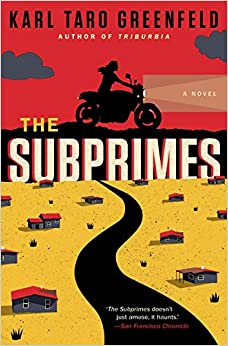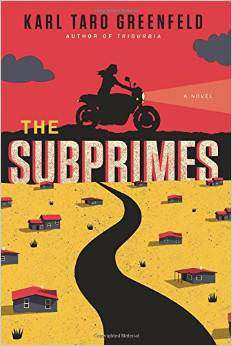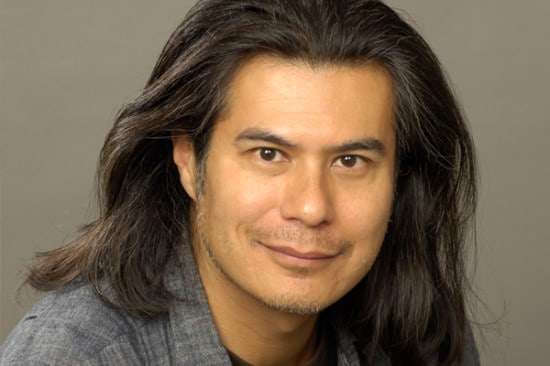The Subprimes by Karl Taro Greenfeld
The hard-knocks imagery in the opening pages of The Subprimes (Harper; May 12, 2015) is riveting. Homeless people, tucked into ragged sleeping bags, are camped out under a “crumbling freeway, so dilapidated and overdue for resurfacing you could glimpse through the cracks the sooty undercarriages of cars passing overhead.” Above that freeway is “an elevated skyway, one of the new toll roads that whisked the wealthy from mansions to airports.” The once-blue sky above is stained with thick, brown smog.
The bleak American tale that Triburbia author Karl Taro Greenfeld tells in his richly imagined and devastatingly dark new novel addresses income inequality and the ever-widening wealth gap. Today, defenders of the gap view America’s richest 1 percent as job creators and saviors of the poor. Greenfeld, who dedicates his novel to “the 99 percent,” drops us into the desperate lives of the disenfranchised in a story that, at first, might seem farfetched but whose trajectory seems possible if not probable as it unfolds.
As in any apocalyptic story, the protagonists are on the run. But unlike the zombie-fleeing heroes in “The Walking Dead” or the displaced families struggling to survive “The Road’s” nuclear catastrophe, the people in The Subprimes are fleeing bank credit agencies and debtors’ prison. Labeled subprimes because of their bad credit scores, they live as pariahs and are denied housing, steady jobs and schools for their children. They live hand-to-mouth, seeking below-minimum-wage day jobs that pay them just enough to purchase some canned goods and a few gallons of gas.
Much like the Joad family in John Steinbeck’s The Grapes of Wrath, these desperate souls have loaded their possessions into rundown vehicles—in this case battered SUVs. They wander from camp to camp, one step ahead of utter hopelessness. It’s so bad that many states are banning people with bad credit scores from crossing their borders.
In the vast wasteland that is Greenfeld’s dystopian America, energy independence is a religion. Environmental laws have been gutted. Renewable energy sources are illegal. Hybrid cars are banned, and the Escalade V24 Turbo is the lowest gas mileage vehicle sold. The country is pocked with once livable towns that are now toxic dead zones as the result of fracking. Greenfeld doesn’t tell us the year in which his novel takes place, but we do know that for 10 years the U.S. has been the world’s largest exporter of petroleum.
In the midst of this daunting world are abandoned subdivisions being taken over by subprimes whose mantra is “people helping people,” and they’re eking out a living in a communal setting that sounds much like the hippie communes of the 20th century.
If I’m neglecting more detailed descriptions of the novel’s characters it’s because they are outshined by Greenfeld’s all-encompassing parody about oil, the environment, the haves and have nots. Even the novel’s savior, Sargam, the almost mystical leader of Valence, a subprime community, is only lightly sketched. The subprimes—wives, husbands, lovers and children —are drawn from stereotypes and sometimes feel more wooden than flesh. They do, however, exemplify human suffering and often outshine their stereotypes through acts of bravery and self-sacrifice. Their suppressed personalities suit them because the 1 percent view them as barely human.
As in all stories of oppression, an epic confrontation must take place and The Subprimes happens in Valence, which comes to represent “the battle of the small against the big, the underclass against the overlords, the subprimes versus the primes.” Several hundred families, led by Sargam, are eking out an existence there. When the “largest privately held petrochemical conglomerate” discovers that Valence is sitting on top of a rich shale old field, Valence’s squatters dig in for a fight.
The hyperbolic symbol of all that is monstrous is the Joshua Extractor, a 22,000-ton shale oil extractor as menacing as the Transformers’ autobots. The extractor, lumbering toward Valence, is so terrifyingly imagined you might mistake that rumbling of fear in your chest for the roar of its engines.
Authors walk a fine line between entertainment and preaching in novels that could also serve as cautionary tales. Steinbeck famously said about The Grapes of Wrath—”I want to put a tag of shame on the greedy bastards who are responsible for this.“ While his novel was carved out of the jagged-edged reality of the 1930s, The Subprimes relies on parody, horror—Stephen King should love this novel—and Greenfeld’s post-modern imagination. No matter the inspiration, both novels take a hard look at what it means to be poor in America.
Buy this Book!
Amazon






